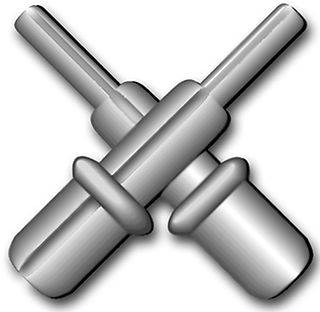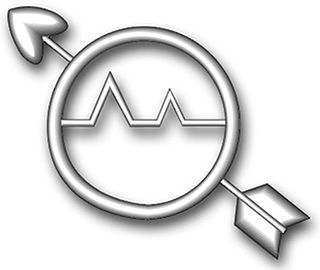| Aviation Ordnanceman | |
|---|---|
 Rating insignia | |
| Issued by | United States Navy |
| Type | Enlisted rating |
| Abbreviation | AO |
| Specialty | Aviation |
Aviation Ordnanceman (abbreviated as AO) is a United States Navy occupational rating.
| Aviation Ordnanceman | |
|---|---|
 Rating insignia | |
| Issued by | United States Navy |
| Type | Enlisted rating |
| Abbreviation | AO |
| Specialty | Aviation |
Aviation Ordnanceman (abbreviated as AO) is a United States Navy occupational rating.

Aviation Ordnancemen operate and handle aviation ordnance equipment. They are responsible for the maintenance of guns, bombs, torpedoes, rockets, and missiles. Their duties include the stowing, issuing, and loading of munitions and small arms. There are three different types of ordnanceman; "O" (organizational) level, "I" (intermediate) level, and "D" (depot) level. O-level ordnanceman are attached to squadrons ashore and afloat. They perform loading/downloading operations on aircraft. I-level perform maintenance on bomb racks, missile launchers, and all other aircraft armament components. as well as store, inventory, issue, and assemble all ordnance. Aviation ordnanceman "A" School is currently held at Pensacola Naval Air Station, in Florida, by the Naval Air Technical Training Center. Aviation ordnanceman training is approximately 5 weeks long. At aviation ordnanceman "A" School, subjects are taught basic aviation theory and skills, along with electronic troubleshooting. To become an aviation ordnanceman, one must have color perception and 20/20 vision or have their vision correctable to 20/20. One must also have an ASVAB score of VE+AR+MK+AS=185 or MK+AS+AO=140. While some aviation ordnanceman tasks require a secret security clearance, all ordnancemen must be eligible for the clearance.
Ship's company, who are stationed on board ship and are also "O" level AOs, work in the magazines below decks or on the flight deck of aircraft carriers. They are in charge of inventory of the weapons on the flight deck whether they are loaded on aircraft or stored behind the island. "I" level ordnancemen work in the aviation intermediate maintenance departments on ships at sea or in facilities ashore. They perform such tasks as preventive maintenance, testing of bomb racks, missile launchers, rocket launchers, handling equipment, loading equipment, aircraft guns for issue to squadrons, and perform any repairs needed. Depot "D" level is for equipment that needs to be completely overhauled and is beyond the capabilities of "I" level maintenance. In a 20-year period, an average aviation ordnanceman spends about 60 percent assigned to fleet units and 40 percent to shore stations.
Aviation Ordnancemen are a close-knit community and one of the few ratings in the U.S. Navy to have their own association, the Association of Aviation Ordnancemen. In addition, aviation ordnanceman had come up with an acronym "IYAOYAS" meaning, "If you ain't ordnance, you ain't shit." One of the most notable aviation ordnancemen was Lieutenant John William Finn, who came up as an enlisted sailor making it to the rank of chief petty officer. He was awarded the Medal of Honor for his actions during the attack on Pearl Harbor on December 7, 1941.

HMS Perseus was a Colossus-class light fleet aircraft carrier built for the Royal Navy during World War II. The ship was initially named HMS Edgar, but she was renamed in 1944 when the Admiralty decided to convert her into an aircraft maintenance carrier. She was completed in 1945, after the end of World War II, and she made a trip to Australia late in the year. Upon her return to the UK in early 1946, Perseus was placed in reserve. The ship was recommissioned in 1950 to serve as the trials ship for the steam catapult then under development. Over 1,600 test launches were conducted before the catapult was removed in 1952 and she was converted for use as a ferry carrier to transport aircraft, troops and equipment overseas. She was reduced to reserve again in 1954 and sold for scrap in 1958.
The Enlisted Aviation Warfare Specialist (EAWS) insignia is a military badge of the United States Navy which was created in March 1980. The insignia recognizes those members of the Navy's enlisted force who have acquired the specific professional skills, knowledge, and military experience that result in qualification for service in the aviation activities of the Navy. This includes most personnel who are trained flight deck personnel onboard aircraft carriers, or maintenance personnel at an Aircraft Intermediate Maintenance Detachment or Department (AIMD) or aircraft squadron.

A hardpoint is an attachment location on a structural frame designed to transfer force and carry an external or internal load. The term is usually used to refer to the mounting points on the airframe of military aircraft that carry weapons, ordnances and support equipments, and also include hardpoints on the wings or fuselage of a military transport aircraft, commercial airliner or private jet where external turbofan jet engines are often mounted.
A parachute rigger is a person who is trained or licensed to pack, maintain or repair parachutes. A rigger is required to understand fabrics, hardware, webbing, regulations, sewing, packing, and other aspects related to the building, packing, repair, and maintenance of parachutes.

The United States Navy and United States Coast Guard occupational rating of gunner's mate (GM) is a designation given by the Bureau of Naval Personnel (BUPERS) to enlisted sailors who either satisfactorily complete initial Gunner's Mate "A" school training, or who "strike" for the rating by showing competence in the field of ordnance. When "striking" one isn't required to be a seaman, but must belong to one of three undesignated rates: Fireman (FN), Seaman (SN), or Airman (AN). It is also possible to cross rate to Gunner's Mate. Cross rating refers to the act of an enlisted sailor "crossing" from their current rating to another rating of their choice, provided their ASVAB scores are high enough and there are open slots for the rate.

Aviation electronics technician (AT) is a US Navy enlisted rating or job specialty. At the paygrade of E-9, ATs merge with the aviation electrician's mate (AE) rating to become avionics technicians (AV). There has been talk of completely merging the two ratings, but as yet no definite plans have been announced. Aviation electronics technicians wear the specialty mark of a winged helium atom.

Aviation Survival Technician (AST) is a rating or job specialty in the United States Coast Guard. Rescue swimmer is the collateral duty or aircrew position of the AST. They are trained at the U.S. Coast Guard's enlisted Aviation Survival Technician/Rescue Swimmer school at Coast Guard Aviation Technical Training Center, Coast Guard Air Station Elizabeth City in Elizabeth City, North Carolina.

Aviation boatswain's mate is a United States Navy occupational rating.

Aviation Machinist's Mates are United States Navy aircraft engine mechanics that inspect, adjust, test, repair, and overhaul aircraft engines and propellers. More specifically, ADs install, maintain, and service various aircraft engine types as well as various accessories, gear boxes, related fuel systems, and lubrication systems; determine reasons for engine degradation using various test equipment; perform propeller repairs; handle and service aircraft ashore or aboard ship; and can also serve as aircrewman in various types of aircraft.
Aviation structural mechanic is a United States Navy occupational rating.

Fire controlman is a United States Navy occupational rating. Often confused with being fireman on board a ship, FCs actually operate advanced weapons systems, whereas Damage Controlman (DC) are actually the shipboard firefighters.

Mineman is a United States Navy occupational rating.

Operations Specialist is a United States Navy and United States Coast Guard occupational rating. It is a sea duty-intensive rating in the Navy while most of Coast Guard OS's are at ashore Command Centers.

The Iowa-class battleships are the most heavily armed warships the United States Navy has ever put to sea, due to the continual development of their onboard weaponry. The first Iowa-class ship was laid down in June 1940; in their World War II configuration, each of the Iowa-class battleships had a main battery of 16-inch (406 mm) guns that could hit targets nearly 20 statute miles (32 km) away with a variety of artillery shells designed for anti-ship or bombardment work. The secondary battery of 5-inch (127 mm) guns could hit targets nearly 9 statute miles (14 km) away with solid projectiles or proximity fuzed shells, and was effective in an anti-aircraft role as well. Each of the four battleships carried a wide array of 20 mm and 40 mm anti-aircraft guns for defense against enemy aircraft.

On 29 July 1967, a fire broke out on board the aircraft carrier USS Forrestal after an electrical anomaly caused a Zuni rocket on an F-4B Phantom to fire, striking an external fuel tank of an A-4 Skyhawk. The flammable jet fuel spilled across the flight deck, ignited, and triggered a chain reaction of explosions that killed 134 sailors and injured 161. At the time, Forrestal was engaged in combat operations in the Gulf of Tonkin, during the Vietnam War. The ship survived, but with damage exceeding US$72 million, not including the damage to aircraft. Future United States Senator John McCain and future four-star admiral and U.S. Pacific Fleet Commander Ronald J. Zlatoper were among the survivors. Another on-board officer, Lieutenant Tom Treanore, later returned to the ship as her commander and retired an admiral.

The United States Navy occupational rating of boatswain's mate is a designation given by the Bureau of Naval Personnel (BUPERS) to enlisted members who were rated or "striking" for the rating as a deck seaman. The colloquial form of address for a boatswain's mate is "Boats".

Modern United States Navy aircraft carrier air operations include the operation of fixed-wing and rotary aircraft on and around an aircraft carrier for performance of combat or noncombat missions. The flight operations are highly evolved, based on experiences dating back to 1922 with USS Langley.
Aircraft Armament Equipment (AAE), also known as Aircraft Armament Systems or Aircraft Ancillary Equipment, encompasses all equipment that is or can be attached either permanently or temporarily to an aircraft, the use of which allows for the carriage and release of airborne stores. AAE includes bomb racks for all practice and tactical, single and multiple weapon design configurations and their aircraft peculiar fairings; pylons and adapter hardware; missile launchers, including their related entities such as power supplies, nitrogen receivers, and aircraft peculiar pylons; adapters, rails, and interface components.
![]() Media related to Aviation Ordnanceman at Wikimedia Commons
Media related to Aviation Ordnanceman at Wikimedia Commons